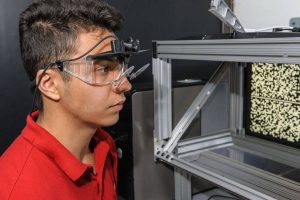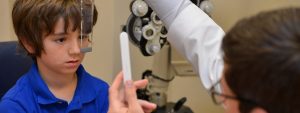Clinical research study shows the effectiveness of vision therapy for the treatment of Convergence insufficiency (CI).
Convergence is an essential visual skill for success in today’s classroom and sports field. This skill enables the ability to focus on near tasks such as reading, for clarity of vision.
Children with convergence insufficiency (CI) have difficulty converging their eyes easily, and as a result, additional effort is required to focus on reading, and other near vision tasks— and to maintain focusing ability for an extended period of time.
What are the symptoms of CI?
- Loss of place
- Loss of concentration
- Reading below grade level
- Eyestrain
- Headaches
- Blurry vision
- Double vision
If your child experiences one of the above symptoms, contact an eye doctor near you.
SEE RELATED: Can Glasses or Eye Patches Treat Convergence Insufficiency?
Convergence insufficiency treatment trial (CITT)
Convergence insufficiency can only be detected and diagnosed during an eye examination, said principal investigator of the CITT, Prof Mitchell Scheiman, O.D., Chief, Pediatric Binocular Vision Service at The Eye Institute of the Pennsylvania College of Optometry.
While the majority of eye care professionals treat children diagnosed with CI using some form of home-based therapy, this study concludes that office-based treatment by a trained therapist along with at-home reinforcement is more effective. The research, reported in the Archives of Ophthalmology, was funded by the National Eye Institute (NEI) as part of the National Institutes of Health.
Background
The 12-week study, known as the Convergence Insufficiency Treatment Trial (CITT), found that approximately 75 percent of those who received in-office therapy by a trained therapist plus at-home treatment reported a resolution of the condition with fewer and less severe symptoms related to reading and other near work.
This NEI-funded study compared the effectiveness of treatment options for convergence insufficiency, said Paul A. Sieving, M.D., Ph.D., director of the NEI. The CITT will provide eye care professionals with the research they need to assist children with this condition.
Method
The CITT included 221 children aged 9 to 17. For the purpose of the study, the children were divided into four groups to compare three different types of vision therapy, and an additional placebo therapy option.
- Group 1 used the treatment option known as ‘pencil push-ups’, an exercise in which patients visually followed a small letter on a pencil as they moved the pencil closer to the bridge of their nose. The goal was to keep the letter clear and single, and to stop if it appeared double.
- Group 2 used only home-based pencil push-ups with additional computer vision therapy.
- Group 3 attended weekly hour-long sessions of office-based vision therapy with a trained therapist and performed at-home reinforcement exercises.
- Group 4 was given placebo vision activities designed to simulate office-based therapy.
Results
After 12 weeks of treatment, normal vision or significantly reduced CI symptoms were recorded in:
- Nearly 75 percent of children who were given the office-based vision therapy, along with at-home reinforcement (group 3)
- Only 33 percent of patients who used home-based pencil push-ups plus computer therapy (group 2)
Conclusion
This study shows that CI can be successfully treated with office-based vision therapy with the guidance and monitoring of a trained therapist, along with at-home reinforcement.
This is very encouraging news for parents, educators, and anyone who may know a child diagnosed with CI.
LEARN MORE: Vision Therapy for Children
Schedule an appointment with an eye doctor for a comprehensive eye exam, and to discuss any questions you may have how to help your child.










